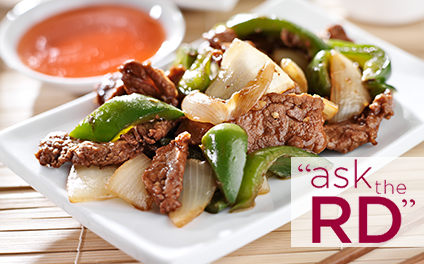By Rachel Rothman, M.S., R.D.
The use of MSG in food products is controversial. Some studies have shown that certain people are sensitive to large amounts of MSG. Knowing where MSG lies when dining out is a bit more complicated, as you are not completely in charge of the ingredients added to your food.
Q: How can I verify if the food I purchase for home use or am eating at a restaurant has MSG added?
A: MSG, or monosodium glutamate, is a food additive and a form of concentrated salt that is added to food to enhance flavor. It is the sodium salt version of glutamic acid, which is an amino acid. Glutamic acid is one of the building blocks of protein. It is naturally present in our bodies and is found virtually in all food, especially in foods high in protein.
The FDA requires that MSG be included in the ingredient statement if it is added to the food product. However, there are many foods that naturally contain MSG, and because MSG is not added to the food, the presence of MSG does not need to be disclosed on the label. Some of these foods include hydrolyzed vegetable protein, autolyzed yeast, hydrolyzed yeast, yeast extract, soy extracts, protein isolate, and even tomatoes and cheese.
The use of MSG in food products is controversial. Some studies have shown that certain people are sensitive to large amounts of MSG. Reactions include headaches, nausea, weakness, and burning sensation in the back of neck and forearms. Some people complain of wheezing, changes in heart rate, and difficulty breathing. Some people claim to be sensitive to very small amounts of MSG, there are not any well designed studies which large enough populations to determine just how little MSG can cause a reaction in the most-sensitive people. People who believe they are sensitive to MSG should be aware that other ingredients, such as natural flavoring, torula yeast, and hydrolyzed vegetable protein, also contain glutamate. Also, foods such as Parmesan cheese and tomatoes, contain glutamate that occurs naturally, but no reactions have been reported to those foods.
Knowing where MSG lies when dining out is a bit more complicated, as you are not completely in charge of the ingredients added to your food. You can ask your server if MSG is added to your dish or if it is in any of the ingredients included in the dish you are ordering, although there is no guarantee that there are not ingredients that naturally contain MSG. My recommendation for you when dining out is to order foods that are less processed and are less likely to contain certain MSG. Choosing restaurant items that include whole foods from fruits, vegetables, lean proteins and whole grains are your best bet for staying away from MSG, along with being the best for you!

